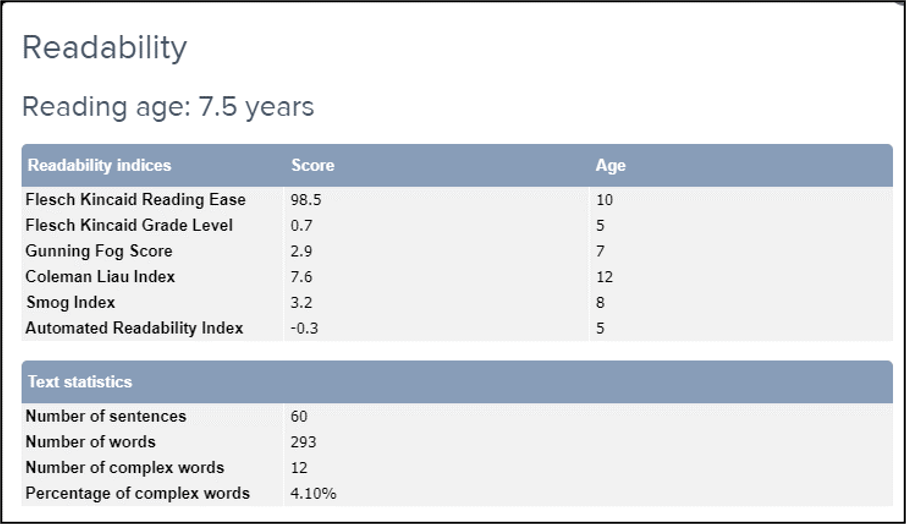21 Oct 2020 | Accessibility

How readable is the written content on your website? If your content is hard to read, confusing or riddled with grammatical mistakes, it can impact your overall website’s success and even how customers feel about your brand.
Improving the readability of your website content is important but is not always straightforward. In this article we’re going to explore how you can improve readability, some of the issues involved and the role automation can play.
What is readability and why is it important?
Wikipedia defines readability as the “ease with which a reader can understand a written text.” While this can relate to a user’s actual ability to view the text on the page, for the purposes of this article “readability” refers to the ability of a user to comprehend the meaning conveyed by the text.
Website content usually has a purpose and therefore will have a meaning; for example, a page may be there to convey information, be part of a particular campaign or focus on a particular call to action. Here the readability of a page can directly impact the ability of a page to meet its purpose; for example, visitors are less likely to click on a “Call to Action (CTA)” if the content that tries to draw them to that CTA is very hard to understand. A more serious example is if information is being provided to notify the general public about issues of health, as we have seen in the current pandemic; here poor readability can mean important messages are misunderstood or ignored. Whatever the purpose of your content, readability is key.
What impacts the ability to comprehend text: considering the audience
The ability of users to comprehend text is impacted by multiple elements such as:
- The vocabulary you use.
- The length of sentences.
- The grammar used.
- Whether you have any mistakes in the text.
- The layout, such as use of paragraphs and headings.
- Even the overall structure of a piece of writing.
However, the readability of your content is also dependent on your audience and their ability to be able to comprehend the text. Readability is often measured in “reading age” although this is a slight misnomer as it does not necessarily mean the actual age of your users:
- Your audience is likely to be highly diverse – not everyone will have English as their first language (or whatever language your content is in).
- Some readers may be dyslexic or have cognitive issues that can impact their ability to understand text.
- Some visitors may have a low reading age – various estimates have suggested that the average reading age in the UK is somewhere between nine and eleven years old although this is open to debate; whatever the truth, adult literacy is a key issue.
Readability also needs to be considered in the context of the target audience of the content, its purpose and the assumed knowledge of that target audience.
For example, the “readability” of content relating to the side effects of medicine would need to be judged differently when that content is instructions for people taking the medicine, compared to the far more technical explanation that would be provided to medical practitioners.
Readability also needs to be considered in the context of how the content is being consumed. A piece of text may be more readable on a browser than it is on a smartphone, for example.
Is readability an accessibility issue?
In the wider sense, readability is an accessibility issue and a wider usability issue. Hard to understand content may not be accessible to your entire audience.
In terms of accessibility compliance, the WCAG 2.1 criteria 3.1.5 states “when text requires reading ability more advanced than the lower secondary education level after removal of proper names and titles, supplemental content, or a version that does not require reading ability more advanced than the lower secondary education level, is available”. However, this is for level AAA accessibility compliance and beyond the current AA standard recommended for websites, so may not directly impact compliance on all websites.
Measuring readability and why readability is highly subjective
There are a variety of different ways to measure readability; among the most well-known are the Flesch Kincaid and Gunning Fog measures. These provide an overall score for the “readability” of your text by equating it to a reading age and taking into account different aspects of the text such as the length of sentences and complexity of words.
These measures can be very useful in indicating if improvements to a page can be made, but it always needs to be remembered fundamentally that readability is always going to be subjective. Scoring and measurement have limitations.
Firstly, there is no consensus on a “one standard measure” of readability. There are at least six different internationally recognised measures relating to readability; these have credibility, but there is no universal “standard” as such. They can also produce varying results on the same piece of text, a factor we explore in more detail below.
Secondly, because of the different needs and abilities of your audience, and the different purposes of your content, a piece of content’s readability cannot be effectively captured by a number. Running a readability score across medical information intended for patients and for medical practitioners is going to be produce different results.
Thirdly, a single score for reading age does not necessarily reflect readability within the whole page. Perhaps the opening half of your page is highly readable, but the latter half is not? Do you score readability across the whole page or across different paragraphs?
Lastly, a score cannot really capture the nuances and meaning conveyed in a piece of writing. Human beings will perceive meaning in different ways. You and I may have different interpretations of a piece of content, and opinions on the associated readability. Any web manager who regularly works with a group of publishers and authors will experience this on a weekly basis!
Using readability scores to actually improve your content also needs to be treated with caution, especially with a diverse group of authors. A “reading age” or score can be a blunt instrument that can be easily misinterpreted as criticism and may not be valid.
The role of automation
Like many aspects of improving websites, automation has a role to play in improving readability, but it’s not so straightforward here.
Cards on the table: because readability is subjective for all the reasons indicated above, at Sitemorse we’ve taken our time in building readability scores into the core platform. However, we do think automated readability scores can play a role in helping content authors to consider where improvements could be made to their content. It’s also something that has been requested by customers, and we’ve listened carefully to feedback.
Therefore, Sitemorse is introducing a new tool to assess the reading age of web pages. This will be available as part of the SMARTVIEW interface; we have introduced it here so content authors can quickly see if there are potential improvements to readability to consider.

Clicking the readability button produces information about the readability of the page:

As already stated, there are several different ways to test readability. Sitemorse has chosen to use standard and well-established tests that are recognised internationally. In discussion with our clients it became apparent that there is no one standard readability test that always produces reliable results. In many cases, the different standard tests can produce a range of results from the same text. Sometimes, one of the tests will produce a widely different result from the others.
Some of our more experienced clients who have been using readability tests on their site for many years do not trust the result of a single test and therefore, they perform several tests and exclude the outlier results. Sitemorse has adopted this pragmatic approach to readability testing.
The page text that Sitemorse tests, is that text contained within page headings (HTML <h1> through <h6>) and text contained within paragraphs (HTML <p>).
When Sitemorse tests text for readability, six tests are performed. These are: Flesch Kincaid Reading Ease; Flesch Kincaid Grade Level; Gunning Fog Score; Coleman Liau Index; Smog Index; and the Automated Readability Index. Each of these produce different values and we convert these values to an equivalent reading age. To exclude the outliers, we take the median value of the test results to give an overall reading age. You can see this in the above screenshot.
Along with the reading age, we also include some statistics for the text that is being assessed. This includes: the number of sentences; the number of words; the number of complex words; and the percentage of complex words.
Should Sitemorse provide a readability assessment score in the same way we produce assessment score for accessibility, links, SEO, etc? Again in discussion with clients, the answer was a definite ‘no’. As we have already discussed, the right reading age for a page depends on the target audience; the ideal reading age for an article about general health targeted at the public might need a reading age of 12 years, whereas the course requirement to study post-graduate quantum electro dynamics would have a much higher appropriate reading age. (Or at least we hope it would!) Ultimately, we don’t feel that adding the readability assessment scores would help make compliance more achievable.
Making your content more readable
Readability is important for website content but there are a lot of factors to consider. Sitemorse now includes readability scores among its capabilities and can help content owners make any necessary tweaks and improvements. Good luck on improving readability on your website!

